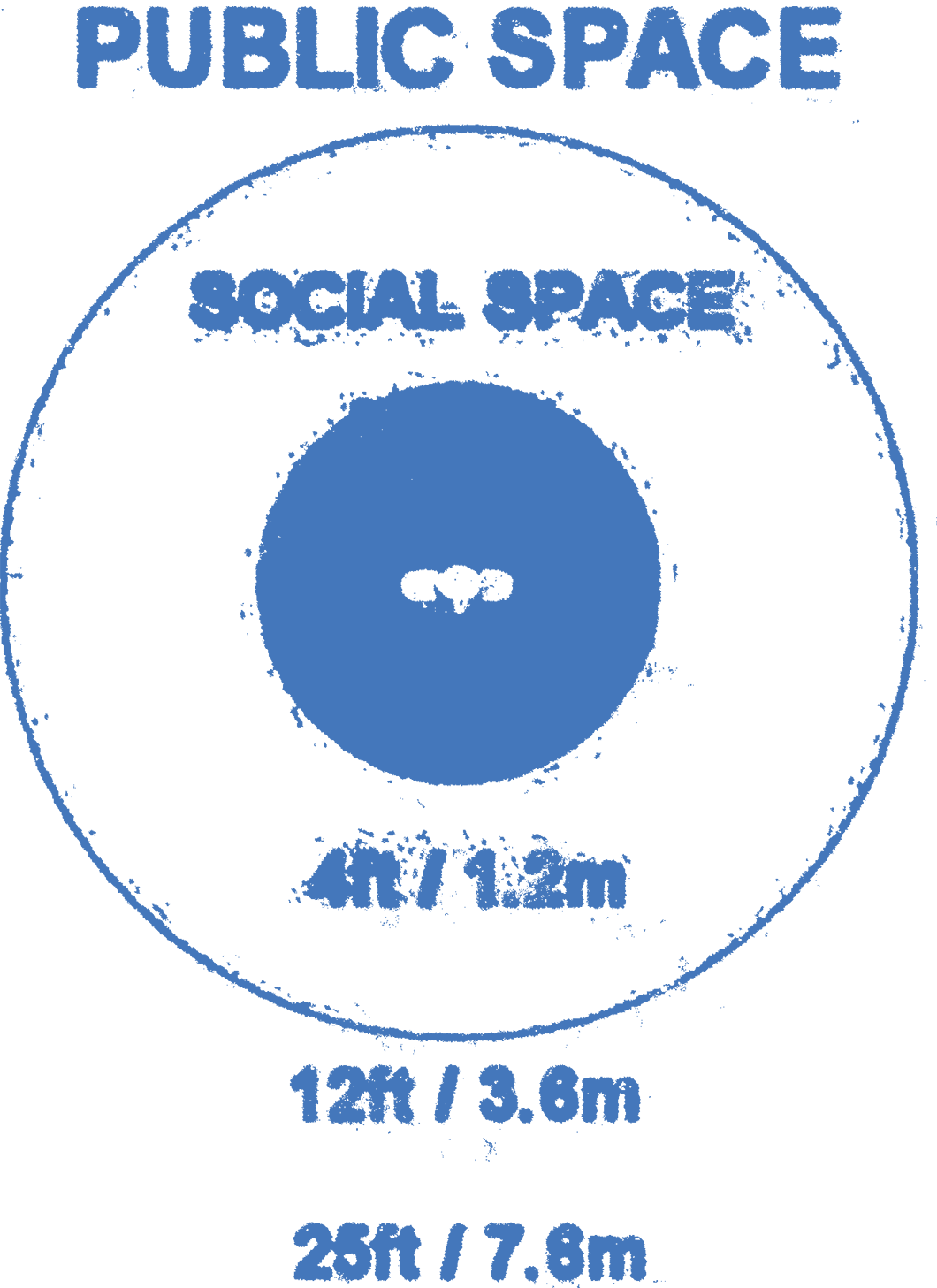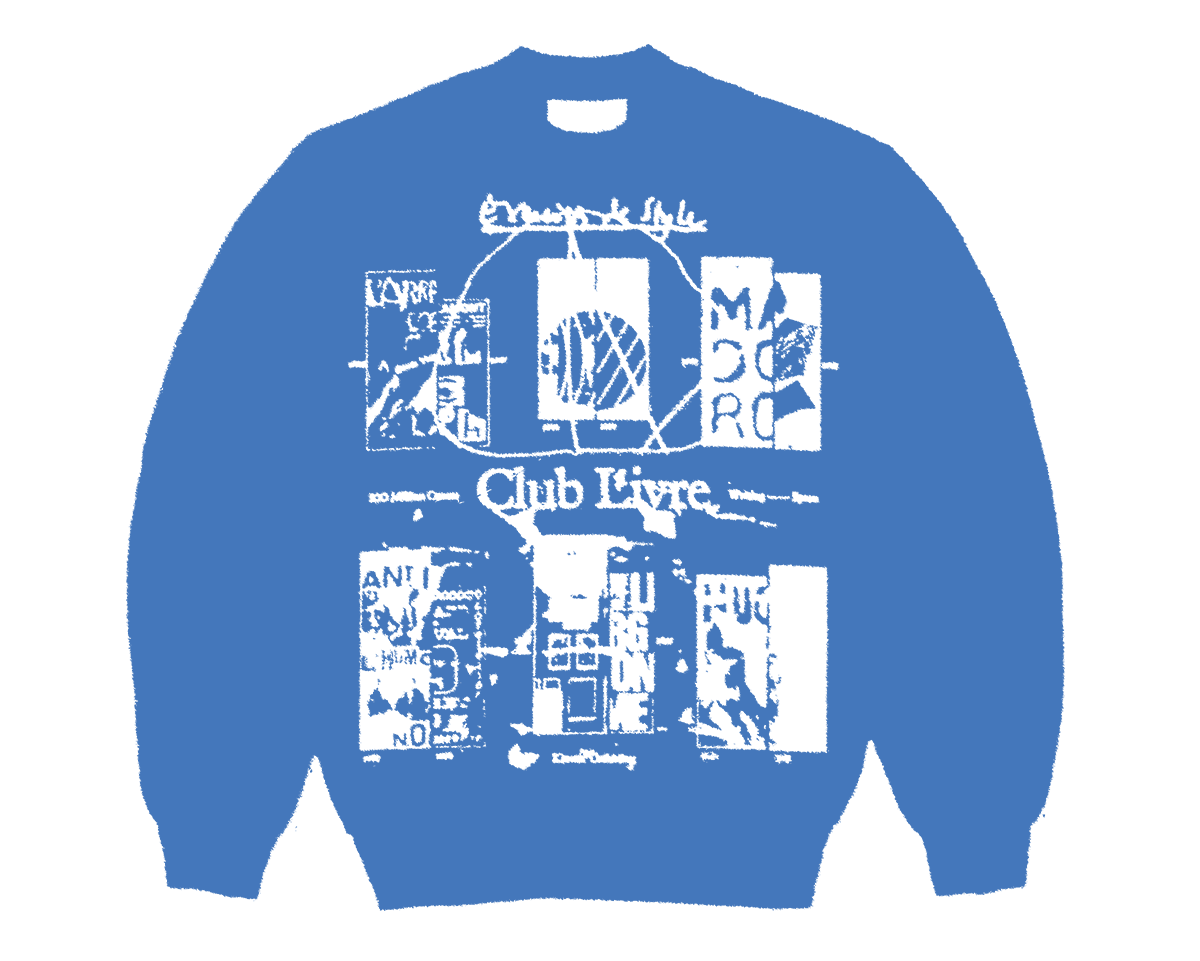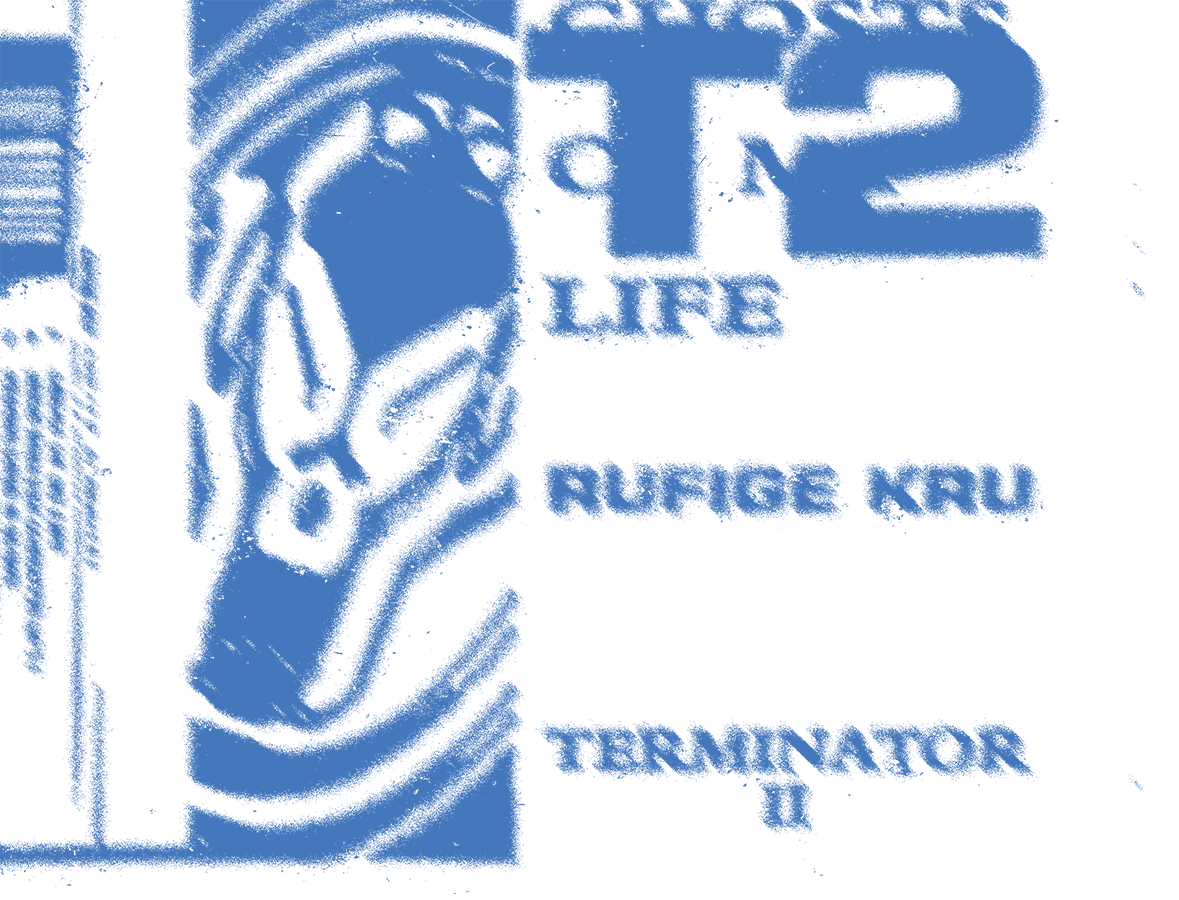INTERVIEW
KEVIN MCCAUGHEY
Kevin McCaughey is a designer and co-founder of Boot Boyz Biz, a research and production cooperative
based in New York.
Kevin’s love for music is apparent in the collection of bootleg clothing Boot Boyz Biz produces. The
most intriguing thing about his practice to me is the research on each specific clothing release,
and how the piece is meant to act as a container for research. His in-depth approach to clothing and
graphic design has influenced my practice and how I think about design. The song he contributed to
the mix was Ghosts of My Life by Rufige Kru aka Goldie, which he
discusses further in
the interview.
CVA
Much of your work uses various forms of noise to communicate an idea or even love for an object. I’m
thinking of both physical noise with distortion of images and noise in musicians such as Björk, Grace
Jones, Yellow Magic Orchestra, and Laurie Anderson. How do you define noise, and what role does noise
serve in the context of graphic design and in your practice?
KM
“Thinking is a putting-aside, rather than a putting-in discipline, e.g., putting aside the tall
grasses in order to isolate the trail into informative viewability. Thinking is FM-frequency
modulation-for it results in tuning-out of irrelevancies as a result of definitive resolution of the
exclusively tuned-in or accepted feed-back messages’ pattern differentiability.”
—Buckminster
Fuller
The stochastic screen (used in print processing and in music formulated by Xenakis) is the modern
update to the classic halftone screen. Whereas the halftone screen is a fixed crystalline structure,
the stochastic (also called FM Screen) is amorphous and undetermined up close. Its noise pattern
brings more resolution but also more chaos to the image. This development resembles the
metamorphosis from modernism to postmodernism.

↑
Visual representation of fixed dot vs stochastic dot spacing

↑
Conventional halftone screening vs stochastic dispersed screening
Noise is still the rhythm of the present — we’re warped by its exploding presence brought by
globalization and technology. The complex task is to read through (not against) noise and collect
the things that empower us, not exhaust and dehumanize us. What empowers us is not what ‘feels good’
but what challenges our current vision of what’s possible and illuminates an alternative — it starts
with a new way of reading noise. We need noise (information) control to function.
Alexander Kluge speaks of the task of developing the ‘dragonfly eye’. Holding many points of view
simultaneously. Nodes that interconnect unevenly. You have to continually speak ‘through’ noise to
connect with the fragmented nonlinear, multi-perspective world. Villem Flusser talks about how our
time is experienced as a pile of sand, not unlike a field of noise. In this sandpile every grain of
sand is a historical event — evidence we depend on for decision making. We construct how we see the
world based on what grains make up the pile. Its form reflects its parts. Is this sandcastle
surrounded by a moat of power or are others outside of power allowed to dismantle its failings and
determine its shape?
Noise can lead the pathway to inquiry — its obscuring power ends the automatism of perception,
slowing it down and complicating meanings, and forces the imagination to fill in the blanks,
disrupting dominant patterns of thought.
I’m thinking of the image of noise and the image of how stars appear to us in the night sky. It’s
incomprehensible as a fragmented whole, but once you start making connections between bright points
(what’s meaningful, useful) a legible picture emerges from noise.
The common thread between the artists you mention is that they resist specialization and refuse to
be pinned down by disciplinary strictures (forced to one constellation) and embrace a kind of
shape-shifting practice, jumping from constellation to constellation, putting the large field of
noise into an interconnected view. This constellation-building practice gets us closer to
understanding noise not as meaningless fragments but as pieces of a complex ‘whole’ that are
interdependent — even though in reality it remains in ‘pieces’.
↑
Pleiades constellation from the Digitized Sky Survey
CVA
One of my favorite tees from you is the Rhythm Prince tee, which is a tee that pays homage to the
drum machine the synth-punk Suicide used. I have a deep love for this tee (outside of my love for
Suicide) because it acted as an educational tool, and created relationships between technology and
art. How do you see the relationship between technology and art in your practice? Do you have any
speculations about what that looks like in the next decade, and will that impact the thinking behind
your output?
KM
The aim is to put this relationship between technology and creativity into clear view. Highlighting
the means of production, the ’how’ of making, not just the ’who’ and ’what’ on the surface. Bringing
to light that creatives are never working alone. We need tools to mediate and our messages are
largely determined by their potential. Its liberatory potential depends on how it’s used and for
whom it benefits.
“Technology is the spark that ignites the powder of nature.”
—Walter Benjamin
Don’t forget, clothing and screen printing are technologies. All mediums are, as extensions of
human abilities. Their full potential has yet to be witnessed. They communicate through echos and
appear on a different layer/order of reality— an imaginative one. The graphic tee cannot work
socially without being worn (though the market and the internet complicate this) and our bodies can
only produce limited visual communication—a symbiotic agreement is made.
In the work we are dependent on so many processes and technologies—from Adobe to our Vastex
Printing Press, the blank t-shirt distributor, and USPS logistics (and many more in between). An
understanding of the whole system that you participate in gives you a heightened economic and
political perspective. You realize that you are “in business” with a lot of people you wish you were
not. This consciousness allows you to make more responsible decisions.
RESEARCH TECH
Information continues to explode onto the internet if you know where to look. But things are also
disappearing. Google obviously
sucks now so people will hopefully start to create new alternative knowledge resources.
PRODUCTION TECH
Screen printing is a big business and slowly evolving technology but the recent developments appear
to be easing the complexity. New tech that eliminates most chemicals involved in screen-burning
could potentially make it easier to print from home, allowing for new experimentation.
Print-on-demand is big and a huge negative for the world, and people increasingly sense the poor
quality-which could spark a demand for hand-prints.
CVA
In Society of the Spectacle, Guy Debord says that “society which
eliminates geographical distance reproduces distance internally as spectacular separation.” With
globalization, and access to information, and commodities what is the role in individuality in
regards to clothing? How do you see graphic tees in creating separation in the individual?
KM
“We are at any moment those who separate the connected or connect the separate.”
—Georg Simmel
Tees in the wild condition us. They link us and repel us. Ack-nowledging this is a redemption of
the ugly term ’streetwear’. It’s training through looking. Architecture and advertising have a
similar semiconscious effect on us. The making of our visual landscape is a making of ourselves;
that means we can realize new forms of connectivity. However, we also make our own passive
alienation. To realize a less separated relationship to the world and each other doesn’t mean just
putting out positive vibes but making objects politically.
In this commodity culture, we have to play with the contradictions for creative advantage, but we
try to eliminate as many as we can without sabotaging the economy of the project. The main
contradiction being the commodity tethered to education and having to sell something for our project
to survive while also providing social value. We produce politically by organizing as a co-operative
and we limit what we produce to our direct abilities— eliminating waste by meeting direct demand and
printing DIY to eliminate alienated production. This way we never have to ‘sell’.
Images that instrumentalize identity lead to an atomized, tribalized engagement with the world that
continues the logic of capitalism and private property. Tees certainly can participate in the petty
“narcissism of small differences.” But this attitude has to be recognized as the immature stage of
engagement with social objects. If we approach images as tools for connecting with others, they can
open up a new kind of collectivity. The image landscape has exploded via technology, and graphic
tees are a mediator for temporarily pinning down forms and ideas to be shared and discussed. Its
virtues derive from their ability to create a unique kind of noise that oscillates between the
personal and collective, subjective and objective, a blurring that speaks to modernity.
The tee is powerful in space, as a ‘proxemic’ actor (Edward T. Hall). One with potential is one
that activates all of the social spaces (personal, social, and public) where its legibility changes
and unrolls as one draws closer or farther. The point is to create contact that wouldn’t happen
otherwise. The tee can be a kind of ‘amulet’ that can improve our spirit and hold our attention
within the whirlwind — batteries storing energy for unexpected use — a counter-spectacle, that
shocks us to wake us up from complacency.

↑
Edward T Hall, “Proxemics” diagram, 1963
Personality is important, and tees can play a role in its development. The association of multiple
free personalities is the ideal of culture. The merging of ideas and disciplines on a tee could
promote the natural merging of personalities into a newly connected network. Here the object
promotes cooperation.

↑
“One big union” cartoon by the Industrial Workers of the World, 1917
Alone in the crowd becomes a socialized space…. A Brechtian refunctioning, transforming the
spectacular crowd into an educational/intellectual/emotional festival. In Debord’s world, this is
close to “détournement”—using the everyday spectacle for different means. A dream that wakes us up
from the dream of the status quo. The sandwich man wearing an advertisement (still the dominant form
of graphic tees) makes up the spectacle of commodities; a different kind of broadcasted message can
make for a counter-spectacle of different hopes, dreams, attitudes, ideas.
Images of the past, left incomplete, can be part of the alt-ernative plan going forward.

↑
“Sandwich board man” representing advertising
CVA
When making a new item, it seems like there is a thorough amount of research and preparation that
happens before the output is clear, and a lot of the research does not make it into the final
output. (Not sure this would even be possible considering how much research goes into each product).
Can you speak a little more about what parts of the research are turned into the final output, and
what makes you focus on specific graphic forms?
KM
The research is often sparked by a simple urge to share something that’s impacted our lives recently
or in the past, but we give ourselves space to complicate this singular subject through an
undetermined digging and stitching process (organization!). On the journey to collect materials and
organize a layout, unexpected material takes us on productive detours where we embrace expanded and
serendipitous connections that unlock something new when illuminated in conjunction with our initial
subject. The research is really an uncovering of a wider labyrinth of connections that isn’t visible
until the pathways are marked, compounding and revealing a new web of information.

↑
Jean Piagets office
How we select is an intuitive process of picking and choosing like anything else. The more you
think with images the better you develop a sense of what images make an impact.

↑
Looking and Seeing - 1: Pattern and Shape, 1964
A tee works when its message penetrates a viewer’s image of the world. The arrangement has to tell
a coherent story, but it requires new pictorial reading that’s nonlinear and more ambiguous. New
intentional relationships between images need to be interpreted. Our moment of “noise” (as discussed
earlier in the text) has conditioned us to experience time polychronically the ability to attend
multiple events simultaniously. The multiple significance of signs on
top of signs is becoming a comfortable pastime. For most it still requires a ‘double take’ taking a
viewer out of automatic perception and
activating thought.
This is the language of film and also of lowly advertising, the front page of newspapers,
19th-century “catchpennies,” ancient illuminated manuscripts, and emblem books from the renaissance
(all ancestors of the poster and t-shirt). They share a common literary method: “headline, image,
caption.” By tapping into this simple tripartite visual rhythm (bass, strings, vocal in music) one
can generate infinite complexity. It’s a starting scheme to be further developed and later turned on
its head.

↑
Emblem book page Alciato, Andrea
Above all the arrangement has to activate the intellectual and emotional, the rational and
irrational. What graphics make it onto an object corresponds to its potential for creating
situations as a worn sign that activates any of these responses. The content and medium have to be
in sync, which means legibility across multiple distances in social settings. If the material is too
banal, novel or illegible it has less of a chance for being noticed. This is all obvious. An
effective way to generate notice is to meet people where they’re at by showing something at once
familiar and unfamiliar, where the new and unknown springs from the already known. Referencing what
people already expect from t-shirts (a 70-year history to draw from) can act as a Trojan horse for
introducing new forms and ideas. When something’s ’slightly off’ people take notice. A simple “logo
flip” is the simplest version of this. Shock is the quickest way to affect someone’s nervous system
but it is not sustainable (unless you’re the New York Post) and people are most generous and open to
a reading when they’re at ease and understand at least part of a visual puzzle right away. This is
also a strategy for building knowledge through constructive links. Tees can then become gateways
into the details we have on the website and become a mnemonic device or a kind of emblem of
compressed thought — a mental map, a sigil, a tool for reflection and memory. A diagram of complex
data that accelerates understanding and reveals routes for deeper exploration. The shirt explodes
inwards spiritually and outwards socially.

↑
John Dee Sigillum Dei

↑
Morphic fields
CVA
Along with the writing, there will also be a mixtape pressed to vinyl. I’m asking influences of my work
to contribute a portion of audio to the vinyl. If you’d be willing, is there any song or audio recording
that you think would best represent your work? Or, any audio you’re currently inspired by that you’d
like to add to the mix?
KM
Rufige Kru aka Goldie — Ghosts of My Life (1993)
This is a guiding spirit. Mark Fisher talked about this one too. It is so emblematic of this drive
we share—to renew the best of the past (here it’s Goldie updating Japan’s “Ghosts” from 1981),
bringing it into constellation with the present (Goldie’s Jungle generation of the early 90s). It’s
a blueprint for using the past as raw material for making something completely new without
diminishing the truth content of the past. A progressive recycling, not impotent melancholic
nostalgia. Here the past and present are on equal footing and in symbiotic relation. To produce
something like this requires a responsible translation. This doesn’t mean any kind of loyalty or
literal translation of the original, but it requires an ability to understand two worlds, multiple
perspectives and languages simultaneously and see how and where they fit together to make unforeseen
sparks. This track is history transformed–made compact and intelligible to a new generation raised
on new sounds with new tools. Writing on top of history, Throughout the track is an acute sense of
danger anticipating pain… but glimmers of hope manage to explode through at 3:04 for about 30
seconds. This is us sifting through trash, the deep storm of information, and by miracle bringing a
pearl or two back up to the surface to share with all.
This track is history transformed—made compact and intelligible to a new generation raised on new
sounds with new tools. Writing on top of history, Throughout the track is an acute sense of danger
anticipating pain… but glimmers of hope manage to explode through at 3:04 for about 30 seconds. This
is us sifting through trash, the deep storm of information, and by miracle bringing a pearl or two
back up to the surface to share with all.
CVA
You have created a unique path in your work. Through Boot Boyz Biz, you have shown designers that it is
possible to create a research-based practice that is educational but also very public. Your work escapes
the walls of academia. Through almost seductive aesthetics, you have created educational tools that
spark conversation. What are your thoughts on the relationship between academia and the public sphere?
KM
My path is marked by a very “unofficial” education, a selfeducation first inherited from the
surface (popular bourgeois sphere), and later in my teens within alternative spaces like online
forums, late 2000s social media, blogs and p2p sites with chat rooms. In those spaces you understand
the real potentials of file-sharing combined with discussion (everyone’s library is a unique
constellation), which becomes a mode of simultaneous building and sharing—a super productive mode
for learning that rivals any “official education.” There you learn to freely express and play with
language (before followers existed). What’s missing are any kind of standards for good writing.
These contingent spaces are organically constructed instead of casted like a season of the Real
World. Engaging with a thousand arguments about why X band is great or X band sucks becomes a
fruitful struggle for constructing knowledge (going beyond the immediate subject).
The history of music is open for discussion and you learn what’s good with enthusiastic (sometimes
toxic) people working to discover for themselves what’s good under their own direct control. But
these spaces are transient, so the aim since then has been to seek out or develop similar and
updated frameworks for continuing to add to this great discussion of what’s valuable (information
war). Aesthetics are involved in convincing people why something matters (rhetoric, propaganda).
Bridging the URL with the IRL was a next step which led me to self-publishing and design.
As my interests evolved beyond music (into design, art, philosophy etc) this method for
self-constructing and presenting knowledge continued, but I found the search for good images and
media from other disciplines located in a different landscape well protected or unavailable online.
Meaning it’s unavailable to most others too. At a certain point of digging you hit proverbial
paywalls or an institutional gatekeeper that denies access to quality material that would help
improve a growing conception of the world for many. Access denied (due to lack of economic or social
capital) requires alternative methods to reach an objective. This involves smuggling — rescuing and
liberating what’s been locked up or hidden is the primary action. Teenage experiences of ripping
unheard records and uploading them to Soulseek is close to the current method of organizing found
material onto ‘objects-to-think-with.’ The movement of mp3s circulating on networks is analogous to
shirts moving through city streets: people log-on and log-off, go out and go home — when the space
is live and shared, information is allowed to flow.

↑
Guy Debord, The Naked City, 1957
There’s a different conception of the “gatekeeper” that I’m drawn to — one with the responsibility
to keep doors open: between disciplines, institutions, and to all differing worldviews. Every
institution (and person) is determined by what ideas are able to be smuggled in and out of its
system. Closed off institutions and specialized individuals are doomed to decay. With open doors and
a flow of information, new forms emerge. The internet has given us keys to previously sealed off
rooms but we still need direction to find their entrances.
History can be told in academic papers as well as in images: which one has a higher probability of
being read? Condensed forms don’t have to be of lesser quality or impact. Any medium and tool has
the ability to drop its therapeutic or entertainment function and become one in the service of
education and socialization. The goal isn’t to replace the academic text, but to lead a person into
it that would never encounter it otherwise, and then carry on its ideas as an educational beacon.
Tees work as potent tools because they’re in touch with the emotions of modern life—the desire to
share signs with hopes of building new associations and knowledge with others through values in
common. Illuminating signs unroll into a new use value, newly organized images lead to newly
organized people (who organizes the images and for what purpose is most important). The meaningful,
surprising interactions mediated by these tools help knowledge stick and generate further inquiry.
As long as the ‘official education’ is reserved for a select few, these unofficial objects like Tees
will provide a similar temporary scaffolding that ignites a process of interiorizing and socializing
knowledge.

↑
Franz Kafka “Gatekeeper” from The Trial
CVA
Do you have any advice for younger designers, artists or people in the world?
KM
Remember that even if you’re working alone, you’re always drawing on a community and a history.
Experiment and decide for yourself (the nice way of saying “f around and find out.”) Discovering “what you do” actually does play a part.
Embrace and take in the whole of life, then give energy (whatever form) back to it. Stirring others to work and enjoyment is the aim. Design without thought is a dead thing.
Continually cultivate a balance between “Live Laugh Love” and a “Ruthless Criticism of All That Exists” without diminishing either.



